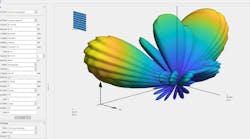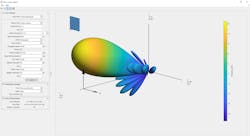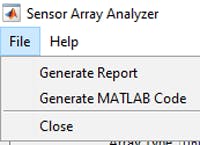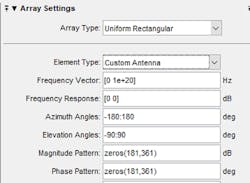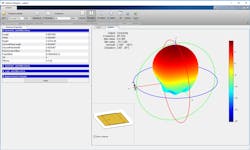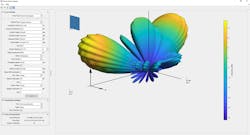In my previous blogs (here, here, and here), I showed how beamforming can be used both to improve signal-to-noise ratio (SNR) and achieve higher channel capacity in multiple-input, multiple-output (MIMO) systems. I also demonstrated how hybrid beamforming can be used to simplify a hardware design, but still maintain the desired system performance. With this background in place, I will now focus on each section of the system design, starting with the antenna element and the array.
Modeling and simulation of antenna arrays can be used in your 5G, radar, and electronic-warfare (EW) workflows to reduce risk and hopefully eliminate rework. The antenna-array design for a MIMO system usually takes one of two paths. In the first path, you iterate on the array parameters, such as element type, element spacing and location, weighting, and the subarray architecture. As the parameters are adjusted, the 2D and 3D patterns can be evaluated across the range of desired steering and angles and frequencies.
1. Shown is the 3D directivity pattern for this array steered in azimuth and elevation.
I have generated the design for a 64-element uniform rectangular array (URA) using the Sensor Array Analyzer app in Phased Array System Toolbox. I will use this antenna array, implemented with subarrays, in future examples. Figure 1 shows the pattern for this array.
Once the design is complete, MATLAB code can be generated directly from the app (Fig. 2). This code will allow you to reproduce the design and iterate as needed in the future.
2. Users can generate a MATLAB script for an antenna array design.
While I used a planar URA in this example, any standard or arbitrary geometry design can be constructed by defining the x, y, and z coordinates, as well as the element normal. This example shows the different types of structures that can be generated with just a few lines of MATLAB code.
A More Detailed View
Once we have the structure of the array, we can take a closer look at the antenna element we use in a bit more detail. In the Sensor Array Analyzer app, I used a built-in ideal element model (with a cosine antenna pattern). This is convenient to get started with, because it shows all its energy in one hemisphere and requires no additional work to implement.
In the 64-element URA design example above, we will get a higher-fidelity model if we use a more accurate model of the antenna element. We can directly import a measured pattern in the Sensor Array Analyzer app that we measured with test equipment. From the Sensor Array Analyzer app, we select the Custom Antenna option and enter magnitude and phase patterns from our measurements (Fig. 3).
3. Here’s the user interface for entering a custom Antenna Pattern for use in an array.
If you don’t have access to a chamber and test equipment, you can also generate a pattern using physics-based solvers and import the patterns directly. Regardless of where you obtain the pattern for the individual element, the array design will use the element pattern(s) as the array patterns are generated.
Let’s look at another app to go deeper with this example. Figure 4 shows the Antenna Designer app. To extend the 66-GHz example, I selected a patch microstrip element from a large library of elements. The 66-GHz patch is typical in a large 5G planar array.
4. This figure shows the Antenna Designer app with patch microstrip antenna element.
This design takes advantage of a method-of-moments (MoM) solver to compute port properties, surface properties, and field properties such as the near-field and far-field radiation pattern. In addition to selecting the element type, I have also provided the desired resonant frequency in the app.
The resulting design can be evaluated in terms of 2D and 3D patterns, the current, impedance, and S-parameters. Similar to the array design above, this design can also be exported directly into the MATLAB workspace, or into a MATLAB script for use in the next portion of your design.
The pattern for the antenna element can be used directly in the large array. Figure 5 shows the resulting array pattern with the new element used in place of the ideal element. As patterns for the array are generated and used in simulation, the beam pattern reflects a higher-fidelity model.
5. This phased-array design uses a patch microstrip antenna element.
While the apps provide an easy way to design antenna arrays and elements, all of the design capabilities are also accessible directly using MATLAB scripts.
Many very interesting workflows are possible with antenna design and MATLAB, and I will review my favorite ones in future posts. You can get started now by checking out these examples.
I mentioned earlier that there are two typical paths for array design. The second path is based on array synthesis. Here you may have a beam pattern as a starting point, or you may want to drive the array pattern in a certain “direction.” For example, this could include lower side lobes, a different beam shape, or perhaps matching a desired pattern. The article “Synthesizing an Array from a Specified Pattern: An Optimization Workflow” provides some examples that realize array-synthesis workflows using optimization techniques.
In the next post, I will describe how mutual coupling can best be modeled and understood in building a large array design using the 64-element array example.
Learn more about specific design options for large antenna arrays or email me at [email protected] with feedback or thoughts along the way.
Learn more about topics covered in this blog post:
- Phased Array Gallery (example): This example shows how to model and visualize a variety of antenna-array geometries with Phased Array System Toolbox.
- Synthesizing an Array from a Specified Pattern: An Optimization Workflow (technical article): This article describes a workflow that uses Phased Array System Toolbox and optimization techniques from Optimization Toolbox and Global Optimization Toolbox to converge on a solution.
- Antenna Toolbox (examples): This page provides more than 40 examples on topics like benchmarking and verification, applications, modeling custom geometry, RF propagation, and external data visualization.
- Phased Array Design and Analysis (example): This example provides an explanation of phased arrays.
- Accelerating 5G Wireless System Development with Hardware Testbeds (white paper): This paper explores an integrated methodology and workflow for the development of advanced algorithms and rapid deployment to hardware testbeds. It discusses their usage in engineering the next generation of wireless communication systems.
See additional 5G, radar, and EW resources, including those referenced in previous blog posts.
